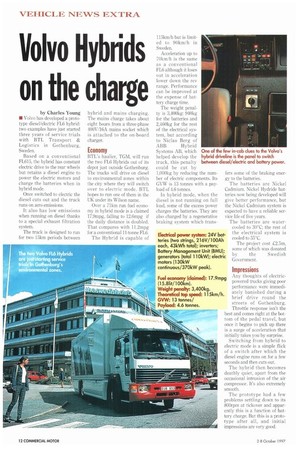Volvo Hybrids on the cha e
Page 14

If you've noticed an error in this article please click here to report it so we can fix it.
by Charles Young • Volvo has developed a prototype diesel/electric FL6 hybrid: two examples have just started three years of service trials with BTL Transport &: Logistics in Gothenburg, Sweden.
Based on a conventional FL615, the hybrid has constant electric drive to the rear wheels but retains a diesel engine to power the electric motors and charge the batteries when in hybrid mode.
Once switched to electric the diesel cuts out and the truck runs on zero emissions.
It also has low emissions when running on diesel thanks to a special exhaust filtration system.
The truck is designed to run for two 15km periods between hybrid and mains charging. The mains charge takes about eight hours from a three-phase 400V/16A mains socket which is attached to the on-board charger.
Economy
BTI,'s haulier, TGM, will run the two FL6 Hybrids out of its depot just outside Gothenburg. The trucks will drive on diesel to environmental zones within the city where they will switch over to electric mode. BTL hopes to run one of them in the UK under its Wilson name.
Over a 71km run fuel economy in hybrid mode is a claimed 17.9mpg, falling to 12.6mpg if the daily distance is doubled. That compares with 11.2mpg for a conventional 11-tonne F1,6.
The Hybrid is capable of 115km/h but is limited to 90km/h in Sweden.
Acceleration up to 70km/h is the same as a conventional FL6 although it loses out in acceleration lower down the rev range. Performance can be improved at the expense of battery charge time.
The weight penally is 3,400kg: 940kg for the batteries and 2,460kg for the rest of the electrical system, but according to Niclas Berg of ABB Hybrid Systems AB, which helped develop the truck, this penalty could be cut by 1,000kg by reducing the number of electric comp(ments. Its GVW is 13 tonnes with a payload of 4.6 tonnes.
In hybrid mode, when the diesel is not running on full load, some of the excess power charges the batteries. They are also charged by a regenerative braking system which trans
fers some of the braking energy to the batteries.
The batteries are Nickel Cadmium. Nickel Hydride batteries now being developed will give better performance, but the Nickel Cadmium system is expected to have a reliable service life of five years.
The batteries are watercooled to 30°C; the rest of the electrical system is cooled to 55°C.
The project cost £2.5m, some of which was donated by the Swedish Government.
Impressions
Any thoughts of electricpowered trucks giving poor performance were immediately banished during a brief drive round the streets of Gothenburg. Throttle response isn't the best and comes right at the bottom of the pedal travel, but once it begins to pick up there is a surge of acceleration that initially takes you by surprise.
Switching from hybrid to electric mode is a simple flick of a switch after which the diesel engine runs on for a few seconds and then cuts out.
The hybrid then becomes deathly quiet, apart from the occasional intrusion of the air compressor. It's also extremely smooth.
The prototype had a few problems settling down to its 800rpm at tickover and apparently this is a function of battery charge. But this is a prototype after all, and initial impressions are very good.








































































































